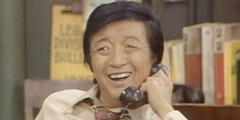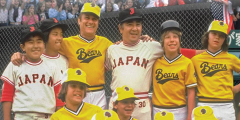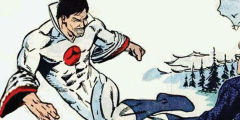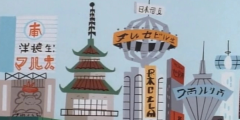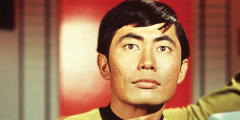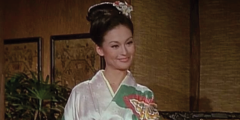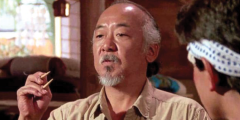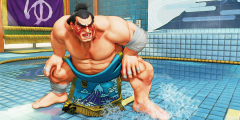Main Page
25 November 2024
| Random Page of 745 |
|
Welcome to Japanifornia's J-Wiki Hey there, fellow enthusiasts of Pan-Pacific pop culture! Welcome to the Japanifornia Wiki, your ultimate destination for exploring the vibrant and dynamic world of Japanese-American heritage and its cultural influences. Like a rich tapestry woven with threads of tradition and modernity, our wiki brings together the best of both worlds, celebrating the unique fusion of Japanese and American cultures. Dive into the fantastical realms of our Fictional entries or geek out over the latest Comics. Discover the profound impact of Japanese artistry in our Japanese Comic Book Characters section, or unravel the intricate storylines of the Marvel Universe and DC Multiverse. Our Television and Movies categories offer a nostalgic trip through iconic shows and films that have shaped our cultural landscape. Explore the fascinating lives and contributions of the Nikkei, delve into the unique experiences of the Hāfu, and immerse yourself in entries originating from Japan itself. Whether you’re a seasoned fan or a curious newcomer, there’s always something new and exciting to discover. |
Now Playing | ||
|
|
Coming Soon: Ultraman: Rising (TV Show), co-directed by John Aoshima, starring Christopher Sean and featuring voice acting from Tamlyn Tomita, Rob Fukuzaki, Gedde Watanabe, and Keone Young. Also Artt Butler, Karen Maruyama, Mayumi Yoshida
| ||
|
Silver Samurai Cameos in the New X-Men '97 | |||
|
In the animated series X-Men '97, Silver Samurai makes a couple of brief yet memorable cameo appearances, both tied to the catastrophic electromagnetic pulse (EMP) events orchestrated by Magneto. The first time we see him, he’s reacting to the initial EMP that plunges the world into darkness. Later, he reappears, witnessing the restoration of power following Professor Xavier's intense psychic battle with Magneto. These scenes effectively underscore the far-reaching impact of Magneto's actions, reminding viewers that the consequences extend far beyond the main cast. For those familiar with the franchise, Silver Samurai's presence in X-Men '97 serves as a nostalgic callback. He originally graced our screens in X-Men: The Animated Series, specifically in season 4, episode 15, titled "Lotus and Steel." In this episode, set in Japan, he faces off against Wolverine. Clad in his iconic armor, Silver Samurai showcases his teleportation abilities and formidable skills in martial arts and swordsmanship. Despite his impressive prowess, Wolverine ultimately defeats him, cementing their rivalry. In the comics, Silver Samurai is well-known as a sworn enemy of Wolverine and the X-Men. His inclusion in X-Men '97 not only adds depth to the story but also ensures continuity with the original series. It’s a clever nod to long-time fans, seamlessly blending the new with the familiar, and highlighting how Magneto’s actions ripple across the globe, affecting even the most peripheral characters. |
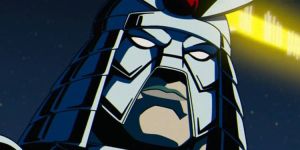 | ||
Most Linked-to Categories
| Rank | Category | Description | Current Count of Members |
|---|---|---|---|
| 1 | Fictional | Entries related to fictional characters and universes. | 614 |
| 2 | Comics | Entries about comic books, characters, and series. | 575 |
| 3 | 🇯🇵 | Entries originating from Japan. | 569 |
| 4 | Hāfu | Entries about people or characters who are half Japanese. | 454 |
| 5 | Television | Entries related to television shows and series. | 449 |
| 6 | Japanese Comic Book Characters | Characters from Japanese comic books. | 428 |
| 7 | Marvel Universe | Entries related to the Marvel comic book universe. | 420 |
| 8 | Earth-616 | Entries about the main continuity in the Marvel Universe. | 209 |
| 9 | Nikkei | Entries about people of Japanese ancestry living outside Japan. | 183 |
| 10 | Movies | Entries related to films and movie series. | 180 |
| 11 | DC Multiverse | Entries about the various universes within the DC Comics. | 174 |
| 12 | 🇺🇸🇯🇵 | Entries about American Japanese origins. | 174 |
| 13 | 🇯🇵🇺🇸 | Entries about Japanese American origins. | 172 |
| 14 | TV Episodes | Entries about individual television episodes. | 181 |
| 15 | Comic Issues | Entries about specific comic book issues. | 134 |
| 16 | The 1970s | Entries related to the 1970s decade. | 134 |
| 17 | Musicians & Singers | Entries about musicians and singers. | 129 |
Japanifornia Icons
| Name | Birth Year | Bio |
|---|---|---|
| Miyoshi Umeki | 1929 | Miyoshi Umeki was the first East-Asian actor to win an Academy Award for her role in "Sayonara" in 1957. |
| Larry Shinoda | 1930 | Larry Shinoda was a Japanese American car designer who designed the Chevrolet Corvette and the Ford Mustang. |
| Yuri Kochiyama | 1921 | Yuri Kochiyama was an American Civil Rights activist who worked with Malcolm X in Harlem. |
| Hiroshi Fujiwara | 1964 | Hiroshi Fujiwara, the Godfather of Streetwear from Japan, collaborated with Tinker Hatfield and Mark Parker at Nike to produce the HTM sub-brand. |
| Steve Yano | 1950 | Steve Yano, with Dr. Dre and Tony A. Da Wizard, produced and sold the Roadium Mixed Tapes at Roadium Swap Meet in Gardena, California in the early 1980s. |
| Wataru Misaka | 1923 | Wataru Misaka broke the color barrier in professional basketball when he played three games for the New York Knicks in 1947. |
| Sessue Hayakawa | 1886 | Sessue Hayakawa was a Japanese actor and matinee idol during the silent film era of the 1910s and early 1920s. |
| Sono Osato | 1919 | Sono Osato was a half Japanese dancer in the 1930s, and later an activist and philanthropist. |
| Isamu Noguchi | 1904 | Isamu Noguchi was a half Japanese sculptor and artist. |
| Rocky Aoki | 1938 | Rocky Aoki was the founder of Benihana, and an incorrigible 60s and 70s philanderer. |
| Michio Kaku | 1947 | Michio Kaku is a theoretical physicist and science communicator known for his work in string theory. |
| Ellison Onizuka | 1946 | Ellison Onizuka was an astronaut who died in the Challenger space shuttle disaster. |
| Kristi Yamaguchi | 1971 | Kristi Yamaguchi is an Olympic gold medalist figure skater. |
| Sab Shimono | 1943 | Sab Shimono is an actor and director known for his work in film and theater. |
| Fred Korematsu | 1919 | Fred Korematsu was a civil rights activist who resisted Japanese American internment during World War II. |
| Patsy Mink | 1927 | Patsy Mink was the first woman of color elected to the U.S. Congress. |
| Richard Aoki | 1938 | Richard Aoki was a civil rights activist and member of the Black Panther Party. |
| Steven Okazaki | 1952 | Steven Okazaki is a documentary filmmaker who won an Academy Award for Best Documentary Short Subject in 1991. |

